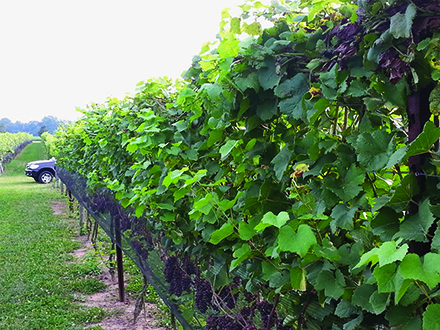
|
|
PRINT » |
|
|
E-MAIL THIS PAGE » |
|
|
CLOSE THIS WINDOW » |
Palissage: An Alternative to Mechanical Hedging
Tip from Alsace grower leads to experimentation in New York

Hedging is a canopy-management technique commonly used by grapegrowers to control excessive shoot growth. Vines with vertically shoot positioned (VSP) canopies can have shoots that grow beyond the top set of catch wires and lean downward, shading the fruiting zone. In non-VSP canopies, long shoots can extend into alleyways, impeding movement through the vineyard.
Although hedging is a widely used practice, it is considered a Band-Aid solution to excessive vine vigor in that it does not address the long-term problem of vine size. There are additional problems with the vines’ response to hedging, particularly that lateral growth is stimulated on the shoot once the tip is cut off. It is then easy for growers to get caught in a vicious cycle of hedging and leaf removal to address the vines’ vegetative growth response.
A potential new canopy-management tool was brought to our attention at the 2008 meeting of the American Society for Enology and Viticulture-Eastern Section. Olivier Humbrecht from Domaine Zind-Humbrecht in Alsace, France, discussed a technique of canopy management that he referred to as “palissage,” where long shoot tips that would normally be hedged are tucked horizontally along the top of the canopy. Humbrecht reported benefits of palissage on Gewürztraminer and Pinot Gris to include earlier cessation of shoot growth during the growing season and reduced/eliminated need for leaf removal in the fruiting zone due to fewer laterals.
Real-life application
Thom Bechtold, vineyard manager at King Ferry Winery in the Finger Lakes region of New York, has been experimenting with the practice since 2009. Bechtold reports that the benefits of palissage as a replacement for hedging include long-term reduction in vine size. I’ve also used the technique for three growing seasons on vigorous Cabernet Franc and Riesling in the Cornell vineyards and found it to be a potentially viable practice.
In 2013, former Cornell viticulture and enology student Jason Hopwood conducted a small preliminary experiment with Pinot Gris in Sudlersville, Md. A randomized complete block design with four replications and two treatments (palissage and hedging) was established. Vines were planted in 2008, trained to double Guyot and cane pruned. Experimental treatments were performed July 22, 2013. Palissage was executed by wrapping vertical shoots along the top catch wire, located approximately 1 meter above the fruiting wire. Manual hedging was performed via use of hedging shears, leaving about 0.3 meters of growth above the top catch wire.
Yield data was taken from two consecutive four-vine panels within each replicate, allowing for two buffer vines on each side of the replication. Fruit was harvested Sept. 15, 2013, and yield data was recorded. Brix, pH and TA were analyzed. Fermentations were completed in duplicate in the Cornell student winery, and wines were bottled using 750ml containers without fining or filtration.
A duo-trio constant reference test was performed with the assistance of two sensory panels. A total of 108 participants (students who were enrolled in the Introduction to Wines and Vines class at Cornell) were asked to choose between two experimental wines to decide which was most similar to an unknown reference sample.
This preliminary trial suggested little effect of palissage on fruit or wine composition. Yield components were not affected, although TA was 0.3 g/L higher in the palissage treatment compared to the control (hedged). Sensory evaluation of the wines did not produce a significant difference among treatments.
My major interest in palissage is in its potential ability to reduce production costs by reducing vegetative growth of the vine. Multiple-year trials at multiple sites are needed to fully elucidate the potential for palissage as a canopy-management tool. I was recently awarded a grant by the New York Farm Viability Institute to further investigate palissage in vinifera vineyards. From our experience with this technique, we estimate the cost of palissage at approximately $50-$100 per acre and savings from the elimination of hedging and the reduction/elimination of leaf removal to be $260-$500 per acre. Other potential results based on our experiences may include increased spray penetration resulting in reduced fruit losses to disease, particularly in tight-clustered cultivars.
Fully replicated trials will be conducted in the Finger Lakes and on Long Island, N.Y., during the 2015 and 2016 growing seasons. Growers interesting in undertaking side-by-side comparisons of hedging and palissage on vinifera vines should contact me at jev32@cornell.edu.
|
|
PRINT » |
|
|
E-MAIL THIS ARTICLE » |
|
|
CLOSE THIS WINDOW » |
